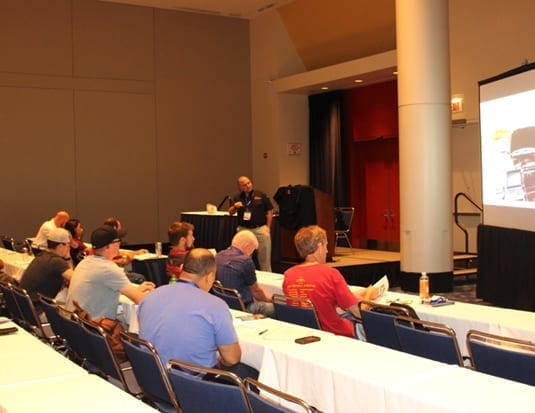Today, diagnostics is an integral part of mechanical repair procedures. No wonder that several workshops and demonstrations at NACE Automechanika Chicago addressed this issue.
NACE Automechanika Chicago, held July 26-29 at McCormick Place (the largest convention centre in North America), presented several workshops for automotive service technicians.
One workshop, led by G. Jerry Truglia and sponsored by NAPA delved into diagnostic procedures as well as the reprogramming of modules using a J2534 analyzer.
Truglia’s approach was interesting because he explained all the steps necessary to get to the right information by accessing vehicle OEM websites. He illustrated his case studies by demonstrating the importance of using this approach for sound diagnosis and procedures in update the modules.
“A client had a problem with his odometer,” he explained to the gathered attendees. “It took me only a quick reprogramming of a module to solve the problem which was a major source of frustration for him. I billed it for work and this new customer was impressed with my technical abilities. He then entrusted me with the regular maintenance of his car. ”
Combining both mechanical and collision segments at NACE Automechanika Chicago, resulted in a module analysis section that was open to all visitors. Collision specialist Mike Anderson; presented his own approach to diagnostics approach which was similar to the mechanical sector and of equal interest to service technicians.
During the Multi-Workshop (MSO) presentations, Justin Klug of OnStar came up with a few quick words to the participants. He explained that with the development of vehicle connectivity that’s taken place, it would not be impossible for a vehicle involved in a collision and/or needing an update or reprogramming, to transmit that information directly to the service centre or repair facility.
As a result, instead of having to go through several, sometimes complex, steps before accessing a car’s data, the technician could pick up the information directly on his or her tablet.
Klug was also quick to point out however that all of this was under consideration, and that the concept of transmitting data to selected third parties was not in GM’s immediate plans. But OnStar technology could facilitate it.
Meanwhile, a company like Mitchell 1, which works closely with Snap-on’s diagnostic tools, emphasis aiding service technicians in performing repair procedures as effectively as possible.
At the Mitchell 1 booth, Tim McDonnell explained the latest developments and software solutions on offer. What was particularly interesting is the enhancement of the additional information available through the SureTrack community. “So technicians can get information on manufacturers’ codes and process solutions, but also validate this information by consulting our extensive data base of actual problems solved by technicians. ”
In summary, access to manufacturers data to diagnose and repair modern vehicles remains is still at the core of the mechanical servicing industry, even here in the U.S. heartland.



